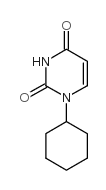Heteroassociation of O- and N-isopropyl derivatives of barbital and phenobarbital with 9-ethyladenine.
E Gentric, J F Menez, J Lauransan, L G Bardou, P Saumagne
Index: Chem. Biol. Interact. 54(1) , 117-25, (1985)
Full Text: HTML
Abstract
Heteroassociation of O- and N-isopropyl derivatives of barbital and phenobarbital with 9-ethyladenine (9-EA) in CCl4 solutions were studied by infrared spectroscopy. Cyclic heterodimers of high stability (725 less than KH less than 1960 1 X mol-1) compared to the corresponding homodimers (20 less than KD less than 60 1 X mol-1) were formed. The heteroassociation constants are interpreted in terms of both the hydrogen bonding tendency of the donor and acceptor centres and the number of sites available for the formation of hydrogen bonds. Such measurements may contribute to the understanding of the interactions between barbiturates, adenosine and their receptors in the brain.
Related Compounds
| Structure | Name/CAS No. | Molecular Formula | Articles |
|---|---|---|---|
 |
1-cyclohexyluracil
CAS:712-43-6 |
C10H14N2O2 |
|
Solvent-dependent photophysics of 1-cyclohexyluracil: ultraf...
2006-09-21 [J. Phys. Chem. B 110(37) , 18641-50, (2006)] |
|
Dynamic properties of interaction between nucleic acid bases...
1989-01-01 [Biochem. Int. 18(1) , 189-95, (1989)] |
|
Fourier transform infrared spectroscopy of 1-cyclohexyluraci...
2009-03-28 [J. Chem. Phys. 130(12) , 125102, (2009)] |
|
Orotic acid decarboxylation in water and nonpolar solvents: ...
2009-09-15 [Biochemistry 48(36) , 8738-45, (2009)] |
|
Effect of protein side chain amide group on the hydrogen-bon...
1989-09-15 [Biophys. Chem. 34(1) , 1-8, (1989)] |